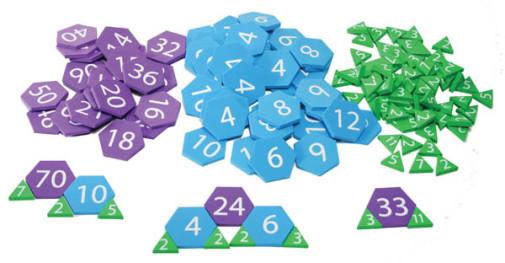We use cookies to make your experience better. To comply with the new e-Privacy directive, we need to ask for your consent to set the cookies. Learn more.
Foam Factor Tiles
Factor tiles are for practicing multiplication up to 12, learning the meaning of prime numbers, understanding factors and creating factor diagrams. This set includes 25 purple starting hexagons (2"), 41 blue factor hexagons (2") and 81 small green prime triangles (1".) The foam pieces are 5mm thick. The goal is to break down the starting hexagon number into its prime factors. Clear instructions are included.
Purple starting hexagons have the numbers: 14, 15, 16, 18, 20, 21, 24, 25, 28, 30, 32, 33, 36, 40, 42, 45, 48, 50, 56, 60, 70, 77, 80, 81, and 90. The blue factor hexagons have the numbers: 4, 6, 8, 9, 10, and 12. The green prime triangles have the numbers: 2, 3, 5, 7, and 11.
Factor tiles will aid students in practicing their multiplication up to 12, learning the meaning of prime numbers, understanding factors and creating factor diagrams. Perfect for quiet group learning. 149 color-coded foam pieces. Largest piece is 2"H. Includes instruction guide with activities and games. Grades 3+
| Product Format: | Other |
|---|---|
| Brand: | SI Manufacturing |
| Grades: | 3-8 |
| EAN/UPC: | 678131146326 |
| Length in Inches: | 13 |
| Width in Inches: | 8.5 |
| Height in Inches: | 0.75 |
| Weight in Pounds: | 0.25 |

